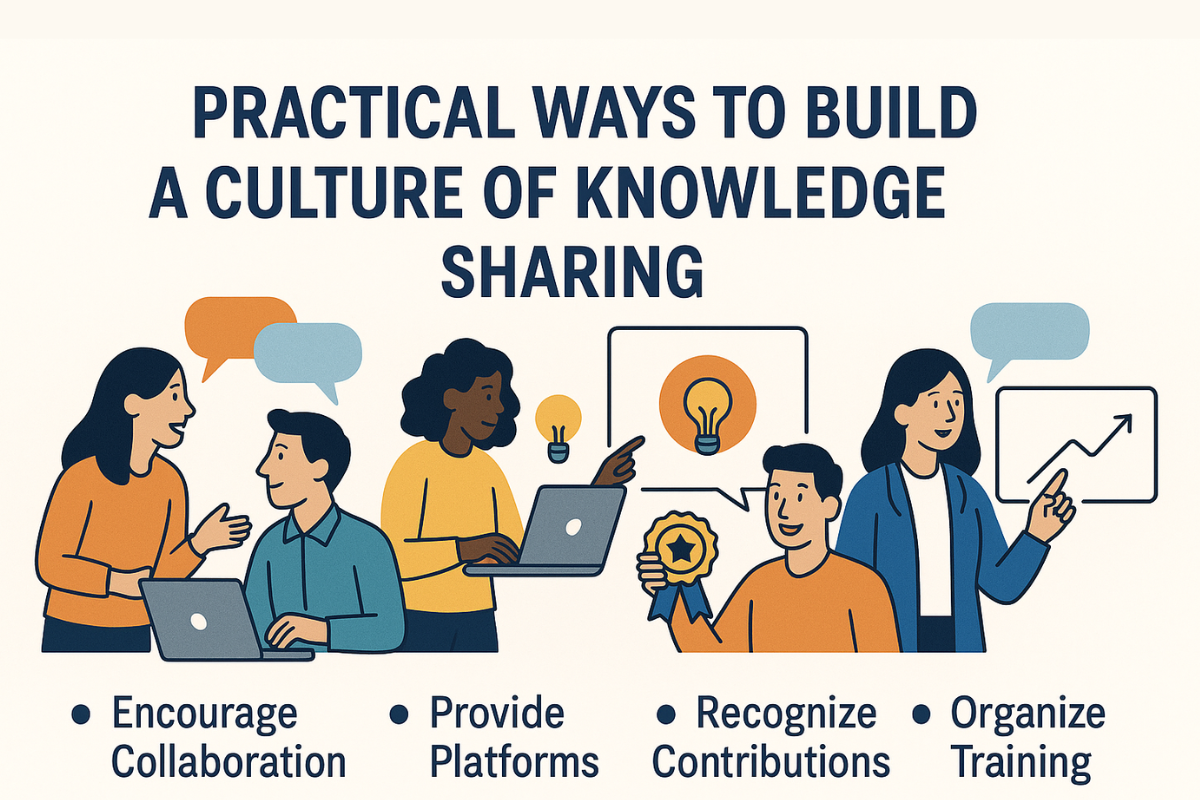Introduction
In today’s fast-paced world, knowledge is one of the most valuable assets an organization can cultivate. Companies thrive not only on innovation but also on how efficiently they share and use knowledge across teams. However, many organizations struggle to create a genuine culture of knowledge sharing.
This blog explores practical strategies to encourage knowledge sharing, why it matters, and how leaders can implement these strategies effectively. To make it easier for readers, we’ve also included a basic information table under the second heading that summarizes actionable approaches.
Practical Ways to Build a Culture of Knowledge Sharing
| Method | Description | Practical Application |
|---|---|---|
| Encourage Open Communication | Foster an environment where employees feel comfortable expressing ideas, asking questions, and sharing solutions. | Create safe spaces like discussion forums, open meetings, and suggestion boxes. |
| Leverage Technology Tools | Use digital platforms for collaboration, such as Slack, Microsoft Teams, or knowledge management systems. | Implement shared drives, project management software, and documentation hubs. |
| Recognize and Reward Contributions | Acknowledge employees who actively share useful insights and knowledge. | Give incentives, recognition awards, or shout-outs in meetings. |
| Create Mentorship Programs | Pair experienced employees with newcomers to transfer expertise. | Implement buddy systems, coaching sessions, or peer learning initiatives. |
| Build Cross-Functional Teams | Encourage collaboration across departments to reduce silos. | Launch interdepartmental projects and brainstorming sessions. |
| Document Best Practices | Store and organize knowledge for easy access by all employees. | Maintain FAQs, guides, case studies, and process documents. |
| Encourage Informal Learning | Provide opportunities for casual sharing outside of structured work. | Host lunch-and-learn sessions, coffee chats, or internal newsletters. |
| Train Leaders to Model Behavior | Leaders should actively demonstrate knowledge sharing in daily work. | Have managers share their experiences, lessons learned, and open resources. |
| Provide Continuous Training | Offer workshops and courses that encourage knowledge exchange. | Use e-learning platforms, webinars, and peer-to-peer teaching sessions. |
| Build a Culture of Trust | Create a safe environment where people are not afraid of criticism or losing their “edge” by sharing. | Promote transparency, fairness, and respect in organizational culture. |
Why Knowledge Sharing Matters
Knowledge sharing is more than just exchanging information—it’s about building collective intelligence. When employees share insights, lessons, and expertise, organizations experience:
- Faster problem-solving: Teams can avoid reinventing the wheel.
- Stronger innovation: Ideas flow more freely, creating opportunities for creative solutions.
- Increased efficiency: Processes improve as best practices are shared.
- Employee growth: Continuous learning supports skill development.
- Resilience: Knowledge sharing prevents dependency on single employees.
Barriers to Knowledge Sharing
While the benefits are clear, several barriers often prevent organizations from creating a true knowledge-sharing culture:
- Fear of criticism or judgment – Employees may hesitate to share if they feel their input will be undervalued.
- Lack of trust – Without trust, employees may hoard information.
- Knowledge silos – Departments or individuals keeping information to themselves.
- Lack of time – Busy schedules leave little room for documentation or discussions.
- Inadequate tools – Outdated or missing platforms make knowledge sharing inconvenient.
Understanding these barriers is the first step to overcoming them.
Practical Steps for Leaders
Leadership plays a crucial role in setting the tone. Leaders can:
- Encourage curiosity and openness during meetings.
- Share their own mistakes and lessons to normalize learning.
- Promote collaboration over competition.
- Provide resources and tools for knowledge management.
- Reward sharing behavior to create long-term motivation.
Using Technology to Enhance Knowledge Sharing
Modern organizations can leverage technology to break barriers:
- Knowledge Bases (Confluence, Notion): Store company documentation.
- Collaboration Tools (Slack, Teams): Real-time communication and idea exchange.
- Project Management Tools (Asana, Trello): Transparent workflows.
- E-learning Platforms (Coursera, Udemy, Internal LMS): Encourage continuous learning.
Encouraging Peer-to-Peer Learning
One of the strongest ways to foster knowledge sharing is peer learning. Organizations can implement:
- Workshops by employees: Let staff members share skills.
- Internal forums: Platforms where employees ask and answer questions.
- Shadowing opportunities: Allowing employees to observe each other’s work.
- Book clubs or study groups: Encouraging collective exploration of new ideas.
The Role of Recognition
Recognition can significantly boost motivation for sharing:
- Public acknowledgment during team meetings.
- Monthly awards for “Knowledge Contributor of the Month.”
- Adding sharing activities to performance reviews.
- Non-monetary rewards like professional growth opportunities.
When employees feel their contributions are valued, they’re more likely to continue sharing.
Building a Long-Term Culture of Knowledge Sharing
True culture change doesn’t happen overnight. It requires:
- Leadership consistency – Leaders must demonstrate and reinforce the value of knowledge sharing.
- Policy integration – Include knowledge-sharing expectations in job roles.
- Measurement and improvement – Track engagement with knowledge platforms.
- Sustained engagement – Keep initiatives fresh with new formats like hackathons, innovation challenges, and storytelling sessions.
Conclusion
A culture of knowledge sharing is not just a workplace trend—it’s a necessity for sustainable growth. By removing barriers, using the right tools, and rewarding contributions, organizations can transform knowledge into a collective advantage.
Start small—encourage open discussions, recognize contributions, and create spaces where learning is celebrated. Over time, these efforts build a resilient, innovative, and collaborative organization where knowledge truly powers success.



